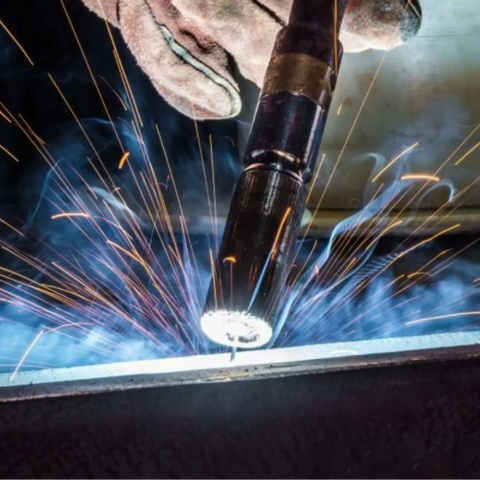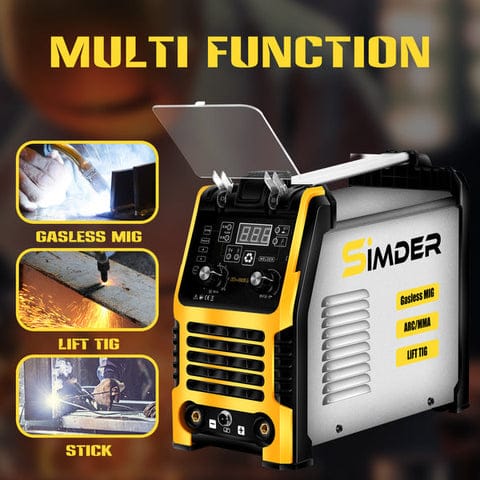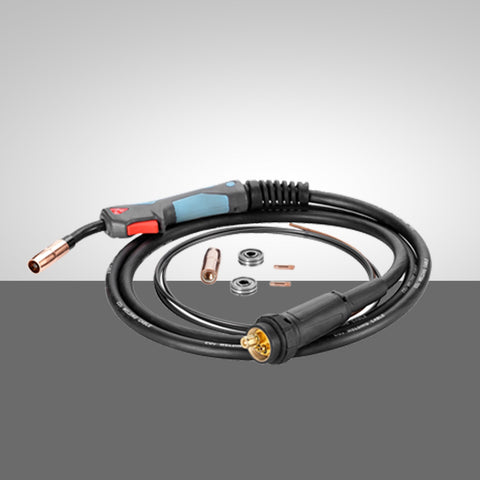How to MIG Weld?
Aug 23, 2023
Mastering the Technique of Metal Inert Gas (MIG) Welding
When it comes to welding techniques Metal Inert Gas (MIG) welding stands out as one of the flexible and commonly employed methods, in various industries. MIG welding, also known as Gas Metal Arc Welding (GMAW) , provides an approach to joining two base materials by melting them using a continuous solid wire electrode. This wire electrode is. Fed into the weld pool through a welding gun. When the wire electrode comes into contact with the welding arc the resulting heat causes the fusion of the base materials ultimately creating a long lasting joint.

Advantages of MIG Welding
There are advantages associated with MIG welding that contribute to its preference in many applications;
Speed and Efficiency; One key advantage of MIG welding lies in its speed and efficiency. The continuous feeding of the wire electrode makes it suitable for high volume production and assembly line applications.
Versatility; MIG welding can be used on a range of materials, including carbon steel, stainless steel, aluminum and various alloys. This versatility makes it an indispensable technique across industries such, as manufacturing, construction and general manufacturing.
Ease of Learning; When it comes to learning welding techniques MIG welding is known for its beginner nature. It's accessible, for those who're new to welding as it doesn't involve complex electrode manipulation allowing for quicker skill development.
Cleaner Process; MIG welding stands out for producing spatter and slag resulting in cleaner and visually appealing welds. This advantage proves valuable in applications where the appearance of the weld matters such as welding.
Controlled Welding Conditions; The utilization of shielding gas during MIG welding plays a role in safeguarding the weld pool against contaminants. This controlled environment ensures high quality welds.
High Deposition Rates; One of the benefits of MIG welding is its ability to achieve deposition rates. This means that welds can be completed quickly which is especially advantageous in industries with time projects.
Suitable for Automation; MIG welding perfectly lends itself to automation and robotic systems. By incorporating precision and repeatability into the welding process productivity increases while labor costs decrease.

Setting Up for MIG Welding
Preparing for MIG welding involves following steps;
- Preparation; Make sure that the workpieces you intend to weld are thoroughly cleaned and free, from rust, dirt or any other contaminants. Proper preparation guarantees quality welds.
- Safety Equipment; Always prioritize safety by wearing gear.
- Make sure you wear the gear, such as welding helmets, gloves and clothing that can shield you from sparks and UV radiation.
- Choosing the Right Equipment; When it comes to selecting the equipment for MIG welding consider the materials you'll be working with. Different MIG welding machines offer voltage and amperage settings so choose one that suits your needs.
- Gas Selection; For shielding gas selection it's important to pick the gas for your application. Argon, helium or a mixture of both are used as shielding gasses. The choice depends on the material being welded and the desired weld characteristics.
- Wire Electrode Selection; When selecting a wire electrode for your project pay attention to its type and diameter. The wire electrode acts as both the heat source and filler metal in MIG welding. So choosing the wire is crucial for achieving desired results.
- Welding Gun and Torch; Ensure you choose a welding gun and torch that match your welding project. Different torch types are designed for applications to ensure wire feeding and optimal welding conditions.
SSimder 15AK MIG Gun
MIG Welding Tips and Best Practices
To ensure MIG welding keep these tips and best practices in mind;
- Maintain a consistent wire feed speed to ensure an arc while avoiding spatter and poor weld quality.
- Hold the welding gun at the angle for best results. The angle you choose can have an impact on the shape and depth of the weld bead. It is generally recommended to have an angle of 5 to 15 degrees from vertical.
- When welding it's important to maintain a travel speed. Moving quickly could result in penetration while moving too slowly can cause excessive heat buildup and distortion.
- To ensure fusion between weld beads and prevent gaps it's helpful to use an overlap technique when making multiple passes.
- To avoid heat input make sure to select voltage and amperage settings. Much heat can lead to burn through and distortion.
- Before welding, ensure that the surface is clean and free from any contaminants. Welding on surfaces can result in porosity. A lack of fusion in the weld.
- Like any skill, practice is crucial for mastering MIG welding. Experimenting with settings, angles and techniques will help improve your proficiency over time.
Troubleshooting Common MIG Welding Issues
While MIG welding offers advantages there are some issues that welders may encounter. Here are a few troubleshooting tips;
- Excessive spatter: This can be caused by incorrect wire feed speed or improper voltage settings. Adjusting these parameters can help reduce spatter.
- Inconsistent bead appearance: This may occur due to varying travel speeds or inadequate shielding gas coverage. Ensure consistent travel speed and proper gas flow.
- Insufficient Penetration: Sometimes the welding voltage may be set low resulting in penetration. To achieve sufficient penetration try increasing the voltage.
- Burn Through: Excessive heat input often causes burn through. To prevent this issue you can adjust the wire feed speed.
- Porosity: If you notice porosity in your welds it could be due to contaminated base materials or improper gas flow. Take time to thoroughly clean the base material and check your gas flow settings.
- Wire Feeding Problems: Problems with wire feeding can occur if the wire tension is improperly adjusted or if there are issues with the liner. It's important to inspect and maintain your wire feeding system.
![]()
SSimder Flux Core Welding Wire E71TGS.035" 2lbs
Where to Find Quality Equipment
When you comes to becoming a MIG welder, having access to reliable equipment is crucial. Whether you're an experienced professional or just starting out, having high quality MIG welding machines, torches, wire electrodes and other essentials can greatly impact your welding results. At SSimder we understand how important it is for welders to have the right equipment for successful projects. Explore our range of MIG welding equipment carefully selected to meet your needs.
If you are a beginner, the SSimder SD-4050 Mini is a very suitable welder for you. Only $105.

SSimder SD-4050 Mini 3 in 1 MIG Welder
Enhance your welding projects with high quality tools and equipment that improve efficiency, precision and the overall quality of your welds. Explore the selection at SSimder to take a step closer to becoming a MIG welder today!
The Last Say:
After choosing the right equipment and preparing the weld pieces, you should select adequate welding parameters. The most crucial parameters include voltage, amperage, and wire speed. The challenge of choosing the correct parameters is that they depend on the thickness of weld metal, wire size, type of metal, joint configuration, welding position, or shielding gas.
To get the best results, follow manufacturer recommendations, which are almost always featured in the instruction manual or inside the wire compartment. In addition, you can use the synergic MIG feature, which is luckily a part of SSIMDER MIG Welding Machines

SSimder SD-4050 Pro
Metal Inert Gas (MIG) welding offers benefits that make it an essential technique in industries. Its speed, efficiency, versatility and user friendly nature make it a popular choice for welders of all levels of expertise.
By understanding the setup process adhering to practices and troubleshooting problems welders can become proficient in MIG welding and consistently achieve excellent welds.
Whether its manufacturing, construction work or general fabrication projects MIG welding plays a role in creating strong and dependable welds that shape our modern world.
Contact us at SSimder for any query and take a step closer to becoming a MIG welder today!





1 comment
do you offer a dedicated TIG unit?